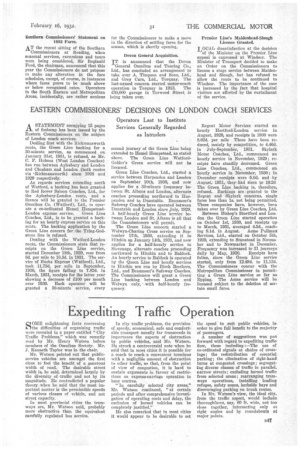Expediting Traffic Operation
Page 65

If you've noticed an error in this article please click here to report it so we can fix it.
OME enlightening facts concerning Isithe difficulties of organizing traffic were revealed in a paper entitled "City Traffic Problems," which was recently read • by Mr. Henry Watsen before members of the Omnibus Society. Mr. J. Kenneth Taylor was in the chair.
Mr. Watson pointed out that publicservice vehicles are amongst the first class to feel the benefit of a generouS width of road. The desirable street width is, he said, determined largely by the diversity of .traffic and not by its magnitude. Be contradicted a popular theory when he said that the most important matter is the permissible speeds of various classes of vehicle, and not street capacity.
In most provincial cities the tramways are, Mr. Watson said, probably more obstructive than the equivalent carefully regulated bus service. In city traffic problems, the provision of speedy, economical, safe and comfortable transport usually far transcends in importance the aspects of obstruction by public vehicles, said Mr. Watson. He struck a controversial note when he said that in most cities it is possible for a coach to reach a convenient terminus with a negligible amount of obstruction to other traffic, so that, from the point of view of congestion, it is hard to sustain arguments in favour of restrictions on express-carriage operation in busy centres.
"In carefully selected city areas," Mr. Watson continued, "at certain periods and after comprehensive investigation of operating costs and delay, the exclusion of horsed vehicles can be completely justified."
He also remarked that in most cities it would appear to be desirable to set the speed to _snit public vehicles, in order to give full benefit to the majority of passengers.
A number of suggestions was put forward with regard to expediting traffic flow, these including :---The use of co-ordinated signals at chains of crossings; the redistribution of essential parking; the elimination of right-hand turns at congested crossings ; segregating diverse classes of traffic in parallel, narrow streets; excluding horsed traffic from selected areas ; rearranging tramways operations, installing loading refuges, safety zones, kerbside bays and discouraging parking on trunk routes.
In Mr. Watson's view, the ideal city. from the traffic aspect, would include thoroughfares, say, 60 ft. wide, not too close together, intersecting only at right angles and by roundabouts at major points.




































































































